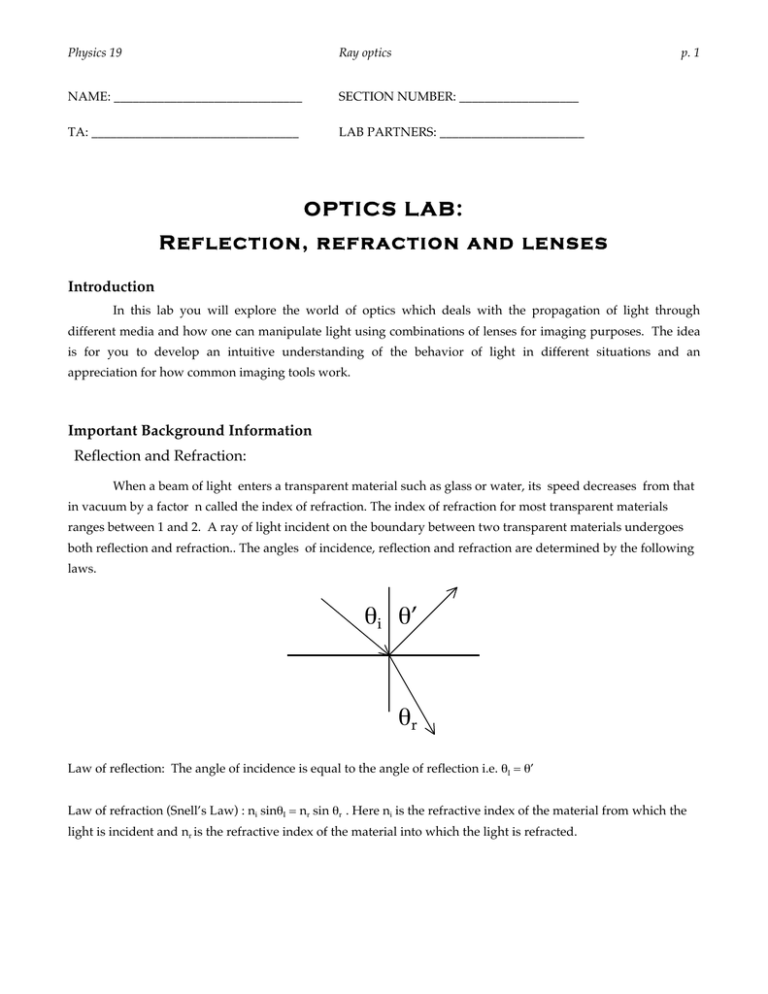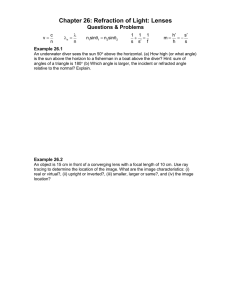θi θ` θr
advertisement

Physics 19 Ray optics p. 1 NAME: ______________________________ SECTION NUMBER: ___________________ TA: _________________________________ LAB PARTNERS: _______________________ OPTICS LAB: Reflection, refraction and lenses Introduction In this lab you will explore the world of optics which deals with the propagation of light through different media and how one can manipulate light using combinations of lenses for imaging purposes. The idea is for you to develop an intuitive understanding of the behavior of light in different situations and an appreciation for how common imaging tools work. Important Background Information Reflection and Refraction: When a beam of light enters a transparent material such as glass or water, its speed decreases from that in vacuum by a factor n called the index of refraction. The index of refraction for most transparent materials ranges between 1 and 2. A ray of light incident on the boundary between two transparent materials undergoes both reflection and refraction.. The angles of incidence, reflection and refraction are determined by the following laws. θi θ’ θr Law of reflection: The angle of incidence is equal to the angle of reflection i.e. θI = θ’ Law of refraction (Snell’s Law) : ni sinθI = nr sin θr . Here ni is the refractive index of the material from which the light is incident and nr is the refractive index of the material into which the light is refracted. Physics 19 Ray optics p. 2 Thin lenses A thin lens is one where the thickness of the lens is small compared to other relevant dimensions such as the radii of curvature of the lens faces. Lenses can be converging or diverging. If parallel rays (e.g. from a far away source) pass through a converging lens they will be brought to a focus at some distance behind the lens. The distance between the center of the lens and the focal point is called the focal length of the lens. A diverging lens on the other hand will spread the rays out. The rays will appear to emanate from a point in front of the lens called the virtual focus. The negative of the distance between this point and the lens center is the focal length of the diverging lens. Thus a diverging lens has a negative focal length. • Draw two diagrams showing parallel rays passing through a converging lens and a diverging lens. Make sure to mark the focal points in both cases. If an object is placed in front of a lens of focal length f at a distance u then the lens will form an image at a distance v. These three quantities are related by the thin-lens equation 1/f = 1/u + 1/v Note that f can be positive (converging lens) or negative (diverging lens) . The image distance v can also be positive. The image is then called a real image and it can be captured on a screen. If v is negative the image is called virtual because it cannot be caught on a screen. Light then appears to come from an image located on the same side of the lens as the object. This is what you see when looking through a diverging lens. Procedure 1. Reflection and refraction Attach a piece of graph paper to the corkboard. Now place the glass slab on it and trace out its outline on the paper. Stick two pins in the board such that the line joining them intersects the long side of the slab at an angle. Now look at the pins through the slab. While doing this stick two more pins into the board on the side of the slab closer to you so that all four pins appear to be in a straight line. Remove the slab. • Are all four pins in a straight line? Why not? Physics 19 • Ray optics p. 3 Consider the ray incident on the slab along the line joining the first two pins. What is the angle of incidence? • Explain why this ray exits the other side of the slab along the line joining the third and fourth pins. • What is the angle of refraction? • Knowing the angle of incidence and refraction, calculate the refractive index of the glass. • Now try to see the reflection of the first two pins by looking at side of the slab closest to the first two pins. Stick in two more pins that seem to be aligned and in a straight line with the first two pins. Use the line joining these two pins to compute the angle of reflection. Does it satisfy the law of reflection? Physics 19 • Ray optics p. 4 Repeat the above by replacing the glass slab with the rectangular plastic container with water in it. Use this to compute the refractive index of water. Thin lenses 2. Mount the lens marked focal length = 10 cm in the lens holder. If you are not sure how to do it ask your TA to show you. • Now try to focus some distant object on to the screen behind the lens. What is the distance between the screen and lens? • Assuming the object is at infinity use the thin lens equation and the above image distance to compute the approximate focal length of the lens. Why is this approximate? Physics 19 • Ray optics p. 5 Now use the light source with the circle and arrow facing the lens. Obtain a focused image on the screen on the other side of the lens. Carefully measure the object and image distances and use the thin lens formula to calculate the focal length. Does this agree with your previous estimate? • Use the image produced above as the object for a second converging lens. Where does the image form? Measure the distances and use this to compute the focal length of the second lens. Physics 19 • Ray optics p. 6 Now use a diverging lens as the second lens. What do you see? How would you measure the focal length of a diverging lens? (bonus)





